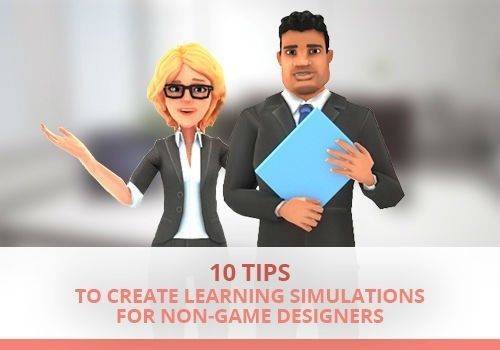Simulations And Games: Types Of Game-Based Learning
Many different types of game-based learning have evolved over the years, each having a different audience and its own unique objective. Here are some alternate gaming styles to consider when designing game-based learning content:
- Flash Cards, Game Show Competitions.
These are best suited for memorization-based or drill-based applications. - Role-Play, Quests.
These work well when the learning objective is to encourage imitation, reinforce continuous practice, and emphasize increasingly challenging content. - Strategy, Adventure.
When the objective is to foster decision-making abilities, or sharpen choice-making and quizzing skills, then these types of games are the best way to go. - Multi-Player Gaming.
These types of games are best suited when fostering collaboration and team work is the ultimate learning objective. - Open-Ended Simulation.
For teaching experimentation and logic, exposing learners to games and simulations that are open-ended (no single wrong/right answer) is the best way to go. - Timed Games, Reflex Testing.
When the objective is to foster quick thinking and thinking “out of the box,” then these types of games are ideal.
Even though the above list classifies each type of game as being the best for specific learning objectives, there is no rule that says game-based learning design can’t mix and match several of these elements into a single course. For instance, role-playing games can easily be based on open-ended simulation techniques.
6 Benefits Of Simulations And Games
True learning is not about memorizing or learning by rote. The right type of simulations and games can challenge and engage a learner into actually comprehending and then practicing new skills. Some of the immediate benefits of well-designed learning games include:
- Active engagement.
Unlike traditional lectures or hands-on training, games push the learner to get actively involved in the learning process. - Adaptability.
Lectures do not offer “try, fail, learn” experiences. With simulations, learners will learn to adapt their skills to the real world. - Self-paced.
The pace of most traditional learning is set by the educator; not so with games and simulations. Learners tailor the pace of the game to match their temperament. - Feedback.
Miss a beat in a game, and you immediately get a “buzz” or “demerits” or lose points. If you do poorly on a traditional test, it may be days before you know how you fared. - Standardization.
When it comes to hands-on training, it’s extremely difficult to assess all learners in a standardized way. Subjectivity invariably creeps in. With simulated learning, the rules are applied equally to all participants, allowing for better learner-to-learner assessments. - Cost-effective.
As opposed to organizing instructor-led or workshop-type learning, simulations are much more cost-effective and broadly distributable.
It’s true that not all learners may initially excel at game-based learning. But when a game is designed with the right components, even the most skeptical learners will eventually embrace it.
Tools Of The Trade
Using the right type of learning-activity focused design tools is essential to create the right game-based learning solution. There are a number of computer-facilitated simulation and game development tools available that can be used for soft-skill simulation, role-playing game development and for creating scenario/story-based content.
Some of the more commonly used tools to develop simulation and gaming content include the following:
Today’s advances in eLearning content development technologies mean that Instructional Designers don’t really need to be software developers or skilled programmers. Designers can simply use the extremely user-friendly User Interfaces (UIs) to provide high-level inputs to these tools, and the tools will do the rest.
5 Ways Of Building Blocks For Game-Based Learning
One of America’s most celebrated educators, James Paul Gee, in his classical book What Video Games Have to Teach Us about Learning and Literacy he has advocated a set of 36 learning principles that designers of game-based eLearning content should adhere to. Here are a few ways that Instructional Designers can incorporate “gamification” into eLearning content while still holding true to Gee’s eLearning principles:
- Defined goals.
Remember that the goals of “gamification” are to harmonize the goals of the game with those of learning. When you start putting together gaming content, know exactly what you want the player to learn as they play the game. - Personalization.
Not every learner learns the same way. When designing game-based eLearning content, Instructional Designers must provide for customized learning experiences (fonts, colors, cast of characters, sounds, “quest” objectives, etc.) to reflect each individual “player’s” preferences. - Gradual progression.
The idea behind this design concept is that learning games should allow players to gradually progress into higher, and more complex, levels of learning. If level 1 (i.e. module 1) is extremely complex, a game player will immediately lose interest for progressing to the next level (module). - Accomplishment.
Gamification of learning is all about reinforcing self-accomplishment amongst learners. Each time a learner clears a simulated hurdle, there must be recognition of his/her accomplishment. - Illustrated progress.
This is a corollary to #3 above, in that games must visually illustrate (through scores, points, accumulated treasure, etc.) the progress gamers make from completing each module/level. Seeing progress in real-time helps keep players motivated to continue playing.
There is great discussion about the approach to incorporating gaming into eLearning. Gaming mechanics should invariably be linked to learning objectives, such as promoting real-world behavior by simulation, and reinforcing proper skills by repetition of activity and constructive feedback.
If you want more information about designing simulations and games, or if you want to learn how to design instructionally sound eLearning courses, please check out the Instructional Design for eLearning: Essential guide to creating successful eLearning courses book. This book is also available in Spanish.







